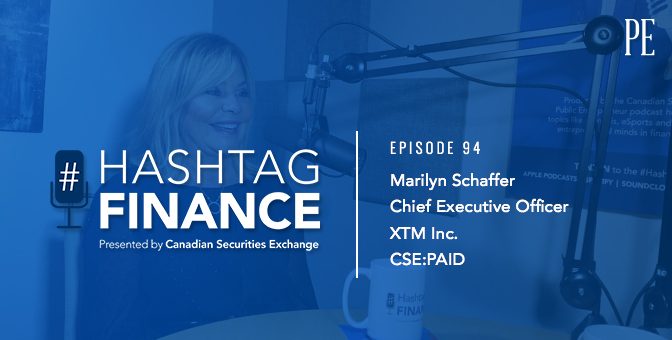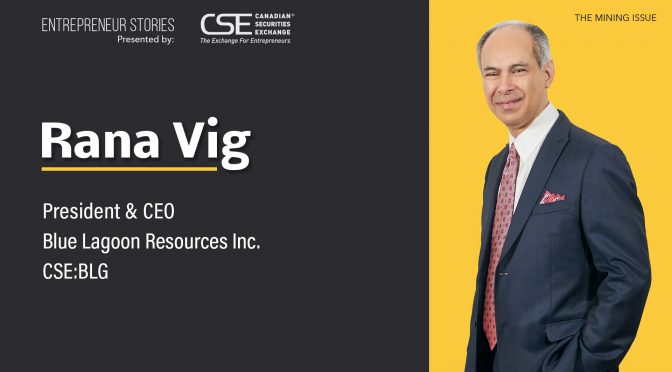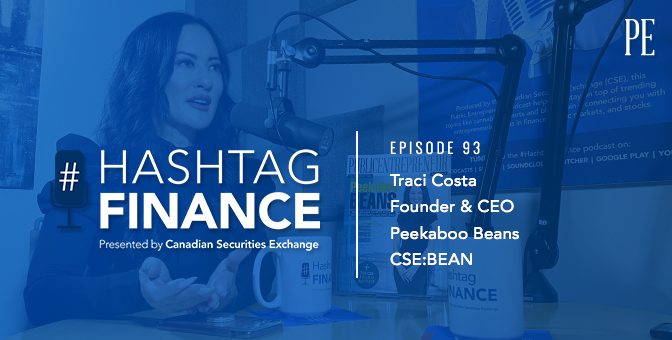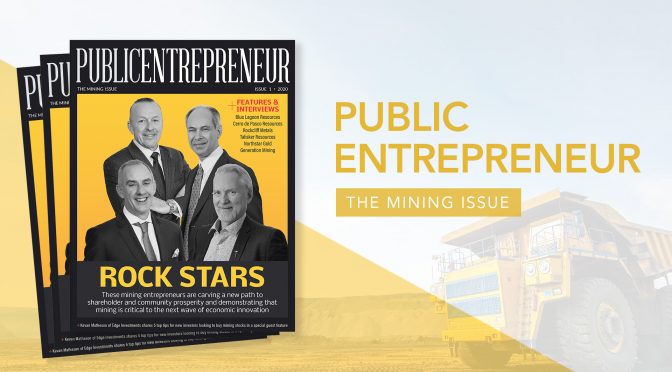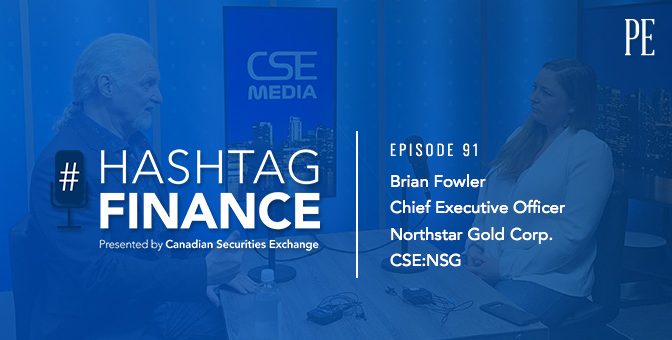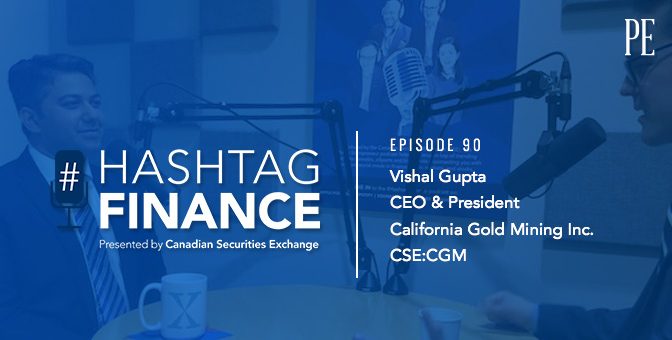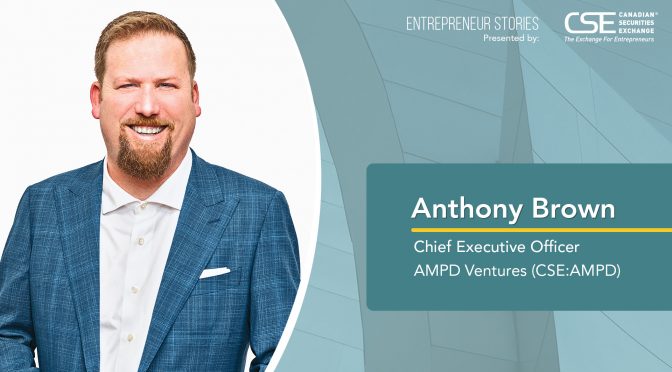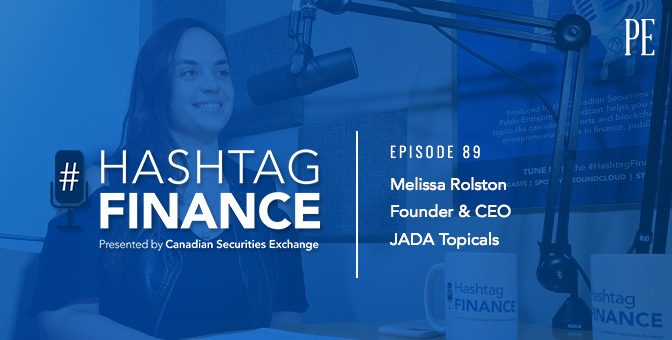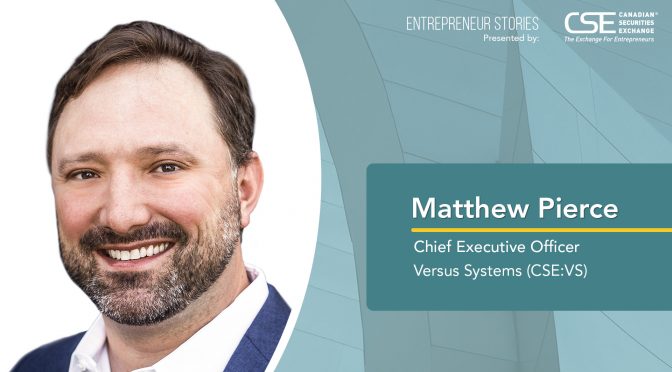What is the profile of a “typical CEO” in the mineral exploration industry? There isn’t one really, though you often find a mix of geology and public markets experience that covers most of the bases. Rana Vig, President and Chief Executive Officer of Blue Lagoon Resources (CSE:BLLG), is cut from a somewhat different cloth, though. He’s listed some of the biggest names in cannabis and runs a highly successful magazine, and that’s just scratching the surface of a very impressive entrepreneurial resumé.
Mining exploration is the outlier in Vig’s career. It’s the one and only sector where commitment and hard work has not resulted in major business success. He plans to do something about that with Blue Lagoon and is off to a good start, with shares in the company gaining 573 percent in 2019, following a July 4th trading debut. Public Entrepreneur shared lunch with Vig in Vancouver recently to learn about the company’s progress so far and what lies ahead.
Let’s begin with a little bit about your background. What brought you into the mining business? And what are some of the career experiences that led to the creation of Blue Lagoon?
Basically, I am an entrepreneur. I have been in business for almost 35 years, and in those years I had five start-ups in different verticals – all private businesses and all family businesses. Around 2010, I connected with a very successful businessman who had made most of his money in mining. He recommended I try something different from the private business world and work with him in capital markets.
I was looking for a change. That 2008/2009 period had just happened when everything was collapsing. It was a dismal time in the business world. So, I got involved with him, invested well over $1 million, and in about six months, it was worth around $10,000, because the mining industry imploded.
Long story short, I don’t know all there is to know about mining, but my goal in every business I enter is to be the dumbest guy in the room, so to speak. I want to surround myself with very, very bright people.
I have a couple of strengths and one of them is executing plans. When everything was collapsing in the public companies I’d become involved with, I took over as CEO and spent several years rebuilding them. Business doesn’t change. Business is business, whether you’re running a restaurant or a magazine, or whatever you are running. The fundamentals are the same. It’s a matter of assembling very smart people who are good at what they do.
I’ve been a CEO, a chairman; I’ve been on boards. To be honest, I’ve met some not so great people in the public company realm, which is something I wasn’t used to in my private business life, but I’ve also met some very good people and developed some meaningful relationships, and they are who I work with.
We will get into your projects in a moment, but first, take us through the concept behind Blue Lagoon. What is the strategy for building the company and creating value for shareholders? What makes Blue Lagoon different?
A couple of years ago, once I’d cleaned up the companies I was involved with, I decided to start fresh. I was very fortunate the last couple of years and brought two of the largest cannabis deals to market. I did a company called Curaleaf, taking them public, and it was the largest cannabis raise in history, at $520 million. I also did Harvest Health & Recreation, which at $300 million was the third largest.
I then had to consider what to do next, and cannabis was retracting. I’ve had nothing but bad experiences in mining since I started in this business. But it has to come back at some point. I concluded that gold has to be the one, the safest place to start. And I launched an exploration company, and that’s Blue Lagoon.
I’m not a geologist or a mining engineer. First and foremost, always bring together real experts in their fields. Then, go out and find undervalued assets, something where I have the opportunity to add value, because that’s how you build value for your shareholders.
We listed Blue Lagoon on July 4th of 2019 at a little over $1 million in market cap, and here we are, seven months later, trading at over $50 million in market cap.
You have a deal with Mag One Products, whereby Blue Lagoon can earn as much as 70 percent in a joint venture by investing $5.25 million in stages. It is an interesting business and an interesting deal structure. Tell us more about how it benefits Blue Lagoon’s value creation effort.
Mag One has great technology that they can rapidly advance. All they need is the money. It is an attractive value proposition for me and my shareholders.
Why magnesium? People have pointed out that we are a gold company, so what are we doing in magnesium? Well, that is the entrepreneur in me. I’m not necessarily trying to build a gold company. I am trying to build a mining exploration company and advance shareholder value. My first and foremost job as a CEO is to create value and make my shareholders happy, because they are coming along for the ride with me.
Magnesium is a great metal. It’s 35 percent lighter than aluminum and over 70 percent lighter than steel. With Tesla and all these electric cars, they want to get lighter. Same thing with planes.
The issue is that magnesium can’t compete with aluminum on price. Enter Mag One. Their technology will compete with aluminum, and even more important is the environmental side. Right now, over 90 percent of the magnesium in the world is produced in China from something called the “Pidgeon process,” which is highly pollutive. But Mag One is zero-emission. All that’s missing is the capital, and $5 million is not a lot of money. If we can supply them with that, it will advance the project.
I believe gold is going to do really well this year, but if it isn’t quite ready to break out yet, then I have this incredible technology that we can help advance. This company has access to 110 million tons of tailings with 23 percent magnesium, so there is no drilling involved. All we need to do is help them advance the science, and we could potentially change the world.
Gordon Lake is a property you optioned in the Northwest Territories. High-grade gold was found over significant widths by previous owners, and you recently announced steps toward conducting your own drilling. Tell us more about the plans and the timeline.
The reason we like the Gordon Lake property so much is that it is in an area known for gold production. The Discovery Mine did over 1 million ounces, the Con Mine did about 5 million ounces, and the Giant Mine did about 7 million ounces.
Being an entrepreneur, the deal is great. It made sense to acquire that to balance our portfolio for summer as well as winter. As for when we are going to start, we have already engaged local experts in the area, Aurora Geosciences. When it freezes, it gives you access to ice roads, which makes it very economical, as you don’t need helicopters. We hope to get started there later in February or early March.
A 43-101 report was released on your Pellaire project in December. There is no resource yet, but there was historical production in the area. Why do you like this one so much and what is the game plan?
Pellaire is a beautiful property a couple of hours southwest of Williams Lake, also in an area known for gold. It has 10 high-grade veins identified. The owners have been at it for years and circumstances brought it available for sale.
We took JDS Engineering, one of the best in what they do, and had them fly up with us and do some analysis.
One of the things that really attracted me to Pellaire is that there is 25,000 tons of crushed rock sitting right by the Number 3 vein. I had JDS help me with a back-of-the-envelope estimation and we believe there is significant value to be had from that, just by trucking it out. That, along with drilling, presents a great upside opportunity.
The precious metals sector has made a measured but undeniable comeback in the last few quarters. What is your outlook for the metals, and what are you hearing that those outside the business don’t know?
I don’t know if there is anything I hear other than what everyone is talking about. Many of these countries are in trouble and there’s currency problems. We know that, at some stage, gold is always the safe haven that people turn to.
If you look at the Indian community, it is a big consumer of gold. I am Indian, and I can tell you that in India, a village will pool its money to buy a gram of gold – not an ounce but a gram. My point is that even the poorest of the poor must somehow acquire gold. That tells me something. It gives me insight about a very large country and its desire to own the metal. That has to come into play at some point, as these deposits are becoming harder and harder to find.
Blue Lagoon closed a financing last year at $1.00, and you just completed another at $1.50 in January. A lot of CEOs would like to be in your shoes. What is the financing environment like for exploration companies? And have you had any feedback from existing or new shareholders that stands out in your mind?
The financing environment is still very tough. I was fortunate to be coming off of two big deals with a solid following of people who believe in me. People believe I have the ability to find the right projects and the right professionals to advance those projects.
We announced $1 million at $1.00 per share and closed $1.1 million – $300,000 of it from me, to show that I am right alongside everyone. The January financing was for $1 million as well, at $1.50.
I never want to be in a position where I am waiting to look for money. I wanted to make sure we had the money secured to advance our projects. We are sitting around $1.5 million in cash.
I also never want to be in a position where my geologist is looking at me and asking if I am going to advance the money to the drillers or not. Being an entrepreneur, one of my principles is that you must always pay your bills. My word is my bond. You can take it to the bank. If I don’t have the money in the bank, I am not going to contract you. I think that is one reason, actually, that I have a good following. Even if things are bad, it is not going to get better if I lie to you.
Let’s close with one of the indispensable lessons you’ve learned in your business career.
It is extremely important to look at who you are investing with. You must believe that person has the ability to take your hard-earned money and grow it. I think you significantly reduce your risk if you sit with the person you are banking on. There are lots of people around the world with great ideas, but we never hear about them because they don’t have the ability to execute. I have the ability to listen, understand, and use my business skills to advance any project. If you are looking at a company to invest in, Blue Lagoon was one of the best performing companies in 2019 and we should at least be on your radar. I believe we have a lot of runway to execute what we are working on now, and what we may acquire in the future.
This story was featured in the Public Entrepreneur magazine.
Learn more about Blue Lagoon Resources at https://www.bluelagoonresources.com/.

